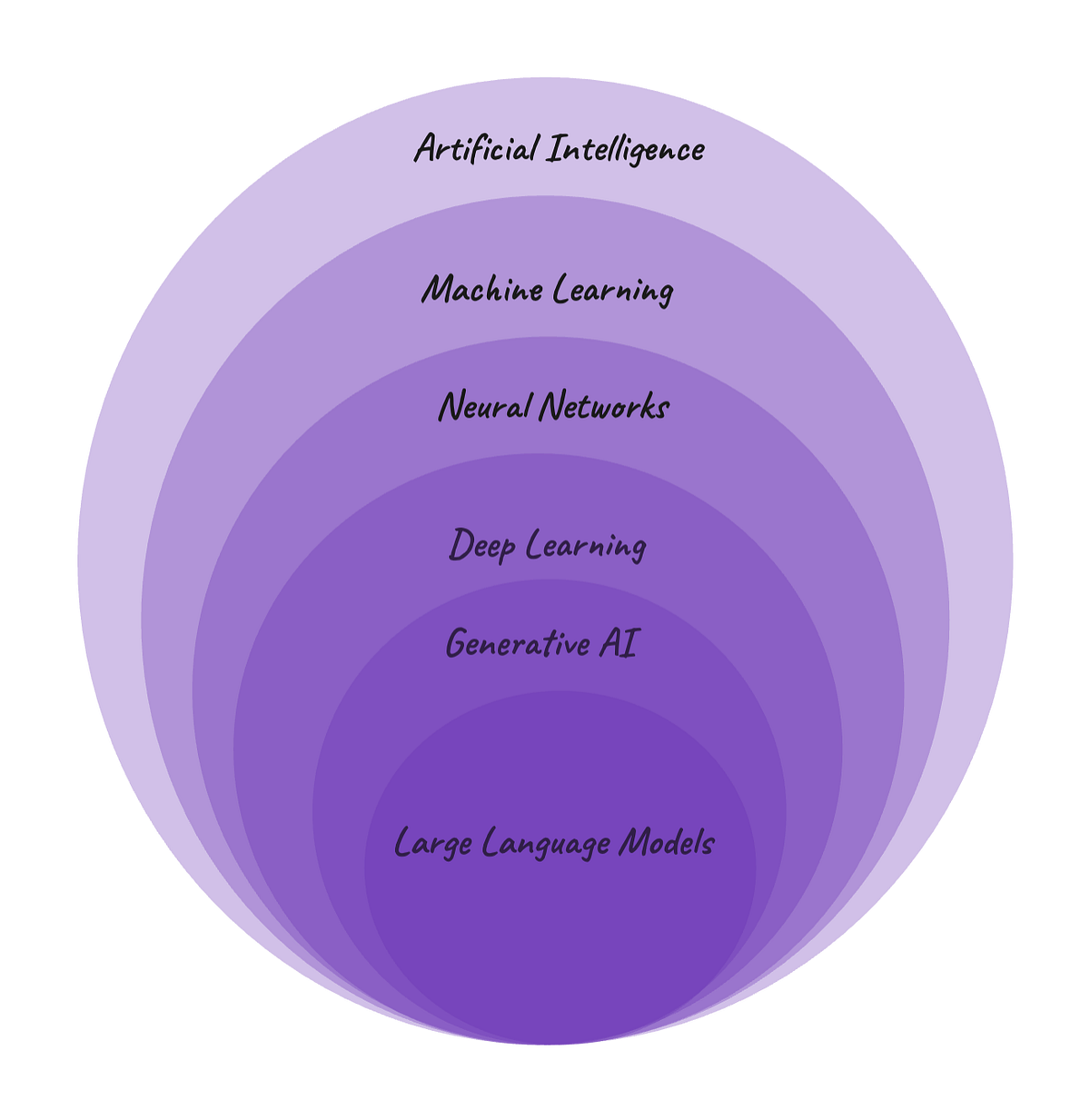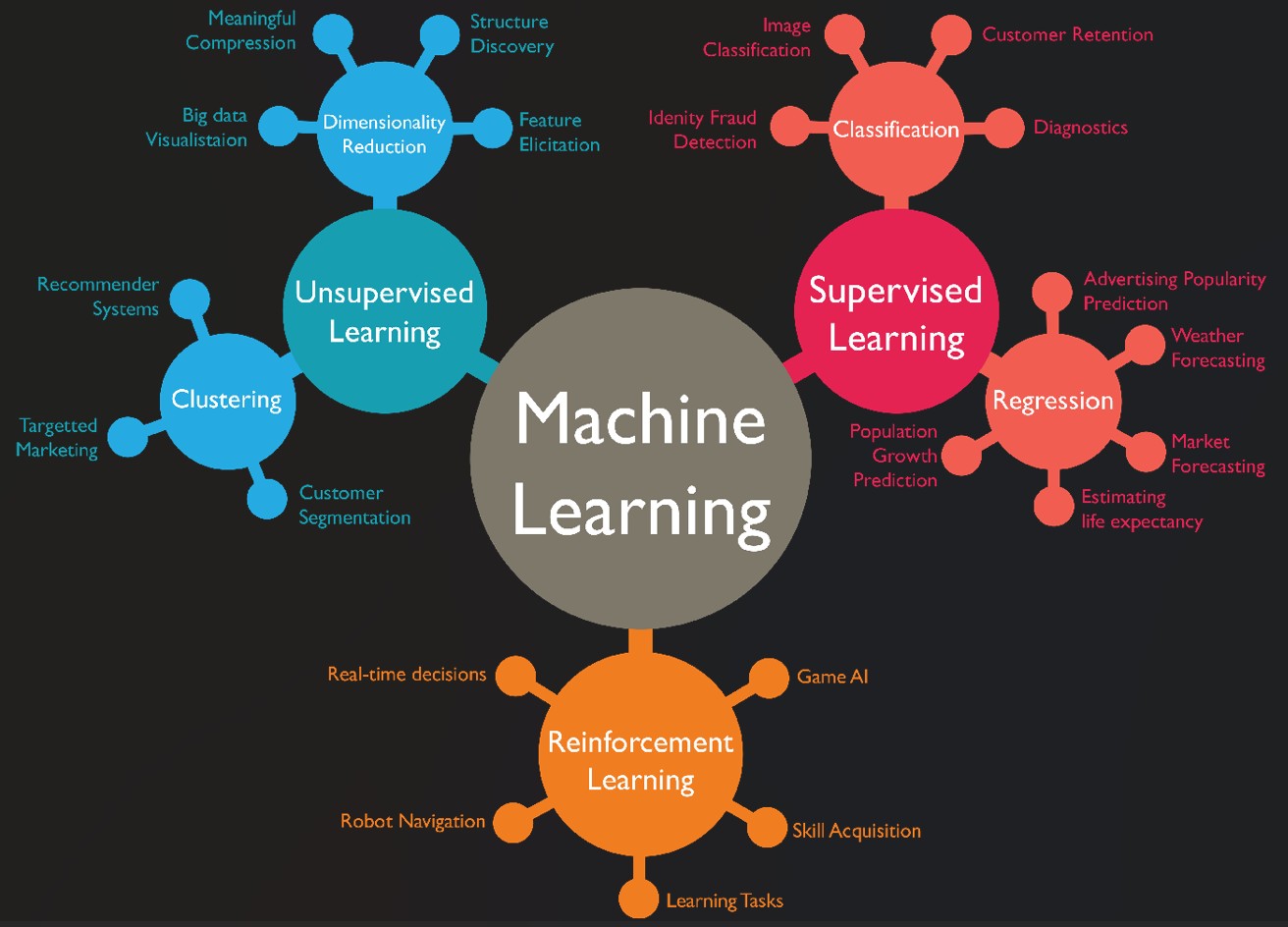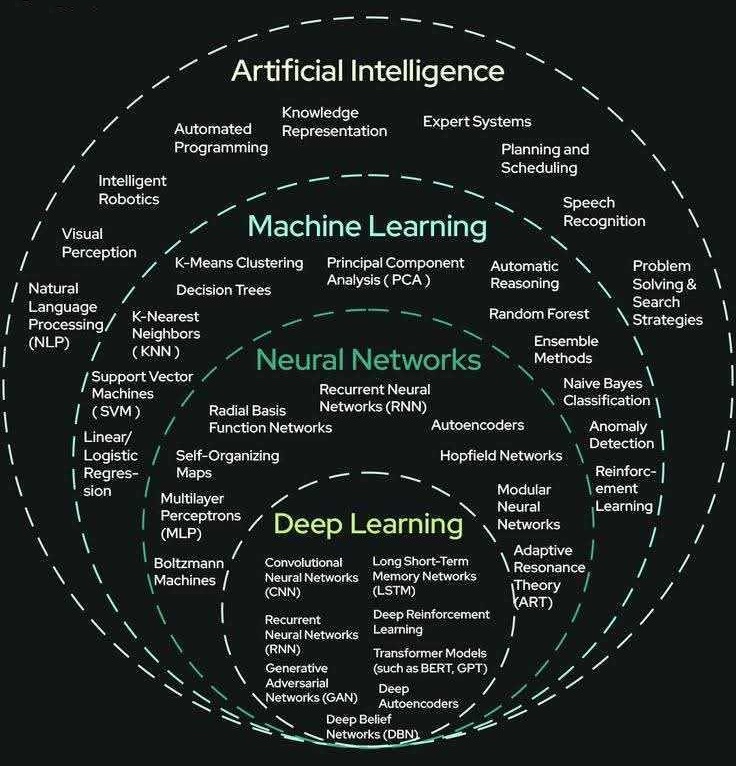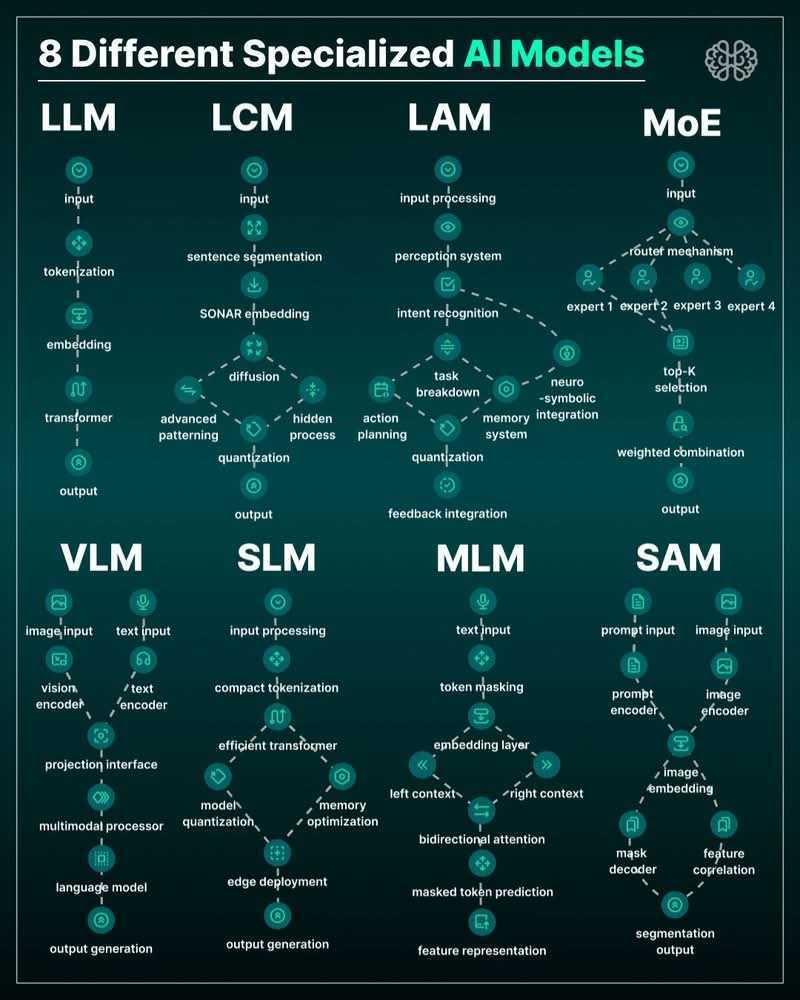
 AI
The term
artificial intelligence
was initiated in 1956 by John McCarthy at the Dartmouth
Workshop.
The workshop established AI as a formal field of study, bringing together
experts in neural networks, computation theory,
and automata theory to explore machine
simulation of human intelligence.
AI
The term
artificial intelligence
was initiated in 1956 by John McCarthy at the Dartmouth
Workshop.
The workshop established AI as a formal field of study, bringing together
experts in neural networks, computation theory,
and automata theory to explore machine
simulation of human intelligence.
Its history traces back to
ancient formal reasoning and
Alan Turing's work
on machine intelligence.
Early AI development started during 1960s
by programs like Logic Theorist and General Problem Solver
that mimicked human problem-solving, and also
after the development of the first AI programming language,
LISP. Early AI research focused on rule-based systems, with a surge in
funding and more complex system development occurring in the 1970s and 1980s.
Quantum machine learning (QML),
is the study of quantum algorithms which solve
machine learning tasks.Read more about Quantum AI ↷
Modern AI (as in
picture and as mentioned in this tutorial) field has continued to evolve with
new techniques,
and the conversation around AI
capabilities has been reignited by recent advancements like large language models,
says Britannica.
AI concepts revolve around creating machines that can simulate human
intelligence through
learning, problem-solving, and decision-making.
It relies on algorithms and vast datasets to recognize patterns, understand language, and
make predictions.
Artificial Intelligence ⇧
Artificial intelligence (AI -
video) is the
simulation of human intelligence in machines,
enabling them to perform tasks like learning, reasoning,
problem-solving, and
perception.
 AI systems use techniques such as machine learning and deep learning
to
analyze data, recognize patterns, and adapt their behavior to achieve goals. This
technology has widespread applications, including automating customer support, enhancing
medical diagnoses, and improving financial fraud detection etc.
AI systems use techniques such as machine learning and deep learning
to
analyze data, recognize patterns, and adapt their behavior to achieve goals. This
technology has widespread applications, including automating customer support, enhancing
medical diagnoses, and improving financial fraud detection etc.
- How
Artificial intelligence Works
Learning from Data: Instead of relying on explicit programming for every situation, AI systems learn from vast amounts of data.
Algorithms: Algorithms, including machine learning and deep learning, process this data to identify patterns, make predictions, and improve performance over time.
Perception and Action: AI systems can perceive their environment through sensors or data inputs, process this information, and then take actions or make decisions to achieve a specific goal.
- Key Capabilities
Problem-Solving and Reasoning: AI can solve complex problems and make informed decisions in unpredictable situations.
Learning and Adaptation: AI systems can improve their performance and adapt their behavior based on new experiences and data sets.
Perception: This includes the ability to "see" (image recognition), "hear" (voice understanding), and process other sensory information.
Language Understanding: AI enables machines to understand and translate both spoken and written language.
- Common
Applications
Customer Service: Automating support with virtual assistants and personalized recommendations.
Retail: Offering personalized shopping experiences, managing inventory, and optimizing store layouts.
Manufacturing: Analyzing factory data to forecast demand and optimize production.
Finance:Identifying fraudulent transactions, performing credit scoring, and managing data.
Healthcare: Acting as personal health coaches and assisting with diagnostics and treatment.
- Benefits and Challenges
Benefits: It can improve efficiency, accuracy, and decision-making across industries, freeing humans from tedious tasks and unlocking valuable insights from data.
Challenges: Concerns exist regarding ethical considerations, including potential biases in algorithms, misuse of AI for malicious content, job displacement, and data privacy.
ML - Machine Learning ⇧
Machine
learning (ML -
video)
is a type of artificial intelligence that allows computer systems
 to learn and improve from data without being explicitly programmed for every task. It
uses statistical algorithms to analyze large datasets, identify patterns, and then
make
predictions or decisions about new, unseen data.
Common types of ML include
supervised
learning (using labeled data), unsupervised learning (finding patterns in unlabeled
data), and reinforcement learning.
to learn and improve from data without being explicitly programmed for every task. It
uses statistical algorithms to analyze large datasets, identify patterns, and then
make
predictions or decisions about new, unseen data.
Common types of ML include
supervised
learning (using labeled data), unsupervised learning (finding patterns in unlabeled
data), and reinforcement learning.
- How
Machine Learning Works
Data: ML systems are fed large amounts of data.
Algorithms: Algorithms analyze this data to find patterns and correlations.
Model Training: The algorithms "train" a model by learning these patterns, much like humans learn from experience.
Predictions/Decisions: The trained model can then be used to make predictions or decisions on new, unseen data.
Improvement: The more data the model processes, the better it becomes at its task.
- Types of Machine Learning,
2
Supervised Learning: The algorithm is trained on labeled data, where the "correct" output is known, allowing it to make predictions for similar new data (e.g., classifying emails as spam or not spam).
Unsupervised Learning: The algorithm works with unlabeled data to discover hidden patterns, groupings, or structures on its own (e.g., grouping customers with similar buying habits).
Reinforcement Learning: The algorithm learns by trial and error, receiving "rewards" for correct actions and "penalties" for incorrect ones, much like a person learns a new skill through practice

- Real-World Applications
Recommendation Engines: Suggesting movies, music, or products based on your past choices (e.g., Netflix, Spotify).
Fraud Detection: Identifying and flagging fraudulent transactions in finance.
Healthcare: Accelerating research, improving diagnostics, and personalizing treatments.
Personal Assistants: Powering virtual assistants and large language models.
Autonomous Vehicles: Enabling cars to "learn" to drive.
NN - Neural Networks ⇧
 Neural networks
(NN -
video)
are a type of machine learning model inspired by the human brain that
learn by identifying patterns in data through interconnected layers of "neurons"
(artificial
neurons - perceptrons).
By
adjusting the strength of connections (weights) between these
artificial neurons during
a process called backpropagation, the network learns to make predictions or
classifications, making it useful for tasks like image recognition, natural language
processing, and complex data analysis.
Neural networks
(NN -
video)
are a type of machine learning model inspired by the human brain that
learn by identifying patterns in data through interconnected layers of "neurons"
(artificial
neurons - perceptrons).
By
adjusting the strength of connections (weights) between these
artificial neurons during
a process called backpropagation, the network learns to make predictions or
classifications, making it useful for tasks like image recognition, natural language
processing, and complex data analysis.
- How Neural Networks Work
Neurons: At the core of a neural network are artificial neurons, or nodes, that receive inputs.
Connections & Weights: Each neuron is connected to others by weighted connections, which represent the strength of the connection.
Layers: Neurons are organized into layers: an input layer that receives data, one or more hidden layers where processing occurs, and an output layer that produces the final result.
Processing: An input signal travels through the network, with each neuron processing its input and passing an output to the next layer.
Training (Learning): During training, the network's weights are adjusted to minimize the difference between its predicted output and the actual desired output for a given task. This is done using an algorithm called backpropagation.
- Key Features
Pattern Recognition: They excel at finding complex patterns and correlations in raw data that might be missed by simpler algorithms.
Adaptability: Neural networks can adapt and continuously improve their performance over time.
Non-linear Processing: They are powerful because they can capture complex, non-linear relationships in data.
- Real World Applications
Image Recognition: Identifying objects and features in images.
Natural Language Processing (NLP): Understanding and generating human language.
Machine Translation: Translating text from one language to another.
Prediction: Forecasting future trends or outcomes based on historical data.
DL - Deep Learning ⇧
 Deep Learning
(DL -
video)
is a branch of machine learning that uses multilayered artificial neural
networks to learn patterns from large amounts of data, similar
to how a human brain
processes information. These complex networks can then be used for tasks like
image and
speech recognition, language translation, and making recommendations, automating
processes that would typically require human intelligence.
Deep Learning
(DL -
video)
is a branch of machine learning that uses multilayered artificial neural
networks to learn patterns from large amounts of data, similar
to how a human brain
processes information. These complex networks can then be used for tasks like
image and
speech recognition, language translation, and making recommendations, automating
processes that would typically require human intelligence.
- How it
works
Neural Networks: Deep learning models use artificial neural networks, which are inspired by the structure and function of the human brain.
Layers: These networks consist of multiple layers—an input layer, several hidden layers, and an output layer.
Learning from Data: Data enters the input layer, is processed through the hidden layers, and results in a prediction or decision from the output layer. The more layers a network has, the "deeper" it is and the more complex patterns it can learn.
Pattern Recognition: Instead of relying on predefined rules, deep learning systems learn to recognize features and relationships directly from raw, often unstructured, data.
- Key characteristics of Deep Learning
Autonomous: Deep learning models can learn and improve their performance through experience with data without human intervention.
Unsupervised Learning: Many deep learning models can work with unlabeled data, extracting relevant features and characteristics on their own.
Complex Problem-Solving: The multilayered architecture allows deep learning to handle complex problems that traditional machine learning models struggle with.
- Real World Applications
Image Recognition: Identifying objects, faces, and scenes in images.
Speech Recognition: Transcribing spoken words into text and enabling voice-controlled devices.
Natural Language Processing: Translating languages, analyzing sentiment, and generating human-like text.
Recommender Systems: Suggesting products or content based on user behavior, such as on Netflix or Amazon.
Robotics: Training robots to perform complex tasks like navigation and manipulation.
More Deep Learning Resources: Deep Learning, Powering the Future of Intelligent Systems

GenAI - Generative Artificial Intelligence ⇧
 Generative AI
(GenAI -
video)
is a type of artificial intelligence that creates new content,
such as
text, images, music, and videos,
by learning patterns from vast datasets and generating
novel, human-like outputs in response to prompts. Unlike traditional AI, which
analyzes
or categorizes data, generative AI produces original material by understanding the
underlying structure of the data it's trained on to predict the next logical element in
a sequence.
Generative AI
(GenAI -
video)
is a type of artificial intelligence that creates new content,
such as
text, images, music, and videos,
by learning patterns from vast datasets and generating
novel, human-like outputs in response to prompts. Unlike traditional AI, which
analyzes
or categorizes data, generative AI produces original material by understanding the
underlying structure of the data it's trained on to predict the next logical element in
a sequence.
- How
Generative AI Works
Training: Generative AI models are trained on immense datasets of existing content, like millions of images or large volumes of text.
Pattern Recognition: During training, the model learns the patterns, structures, and relationships within this data.
Content Generation: When given a prompt, the model uses these learned patterns to generate new, original content that mimics the style and characteristics of its training data
- Key characteristics of Gen AI
Content Creation: Its primary function is to generate new content rather than just analyze existing information.
Creativity: It uses algorithms to mimic human creativity by producing unique material.
Prompt-Driven: It responds to user inputs or "prompts" to create specific content, such as generating an image of a person who doesn't exist from a textual description.
- Common Types of Generative AI
Large Language Models (LLMs): Used for generating text-based content, including conversations, stories, and code.
Image Generators: Create new images from textual descriptions.
Audio and Video Tools: Generate new music, sound effects, or video clips
- Use Cases
Content Creation: Assisting with writing marketing copy, creating background music, or generating script ideas.
Design: Generating product designs or creating realistic images of non-existent people.
Software Development: Generating code or assisting with code review.
LLM - Large Language Models ⇧
 Large
Language Models
(LLMs -
video)
are a form of artificial intelligence that process and
generate human-like text by learning from vast amounts of data. They power generative
AI, excelling at tasks like text generation, translation, summarization, and
answering
questions by understanding complex language patterns using transformer
architectures.
LLMs achieve their capabilities through deep learning on massive datasets and interact
with users via natural language prompts, though they face challenges related
to cost,
data bias, and potential misinformation.
Large
Language Models
(LLMs -
video)
are a form of artificial intelligence that process and
generate human-like text by learning from vast amounts of data. They power generative
AI, excelling at tasks like text generation, translation, summarization, and
answering
questions by understanding complex language patterns using transformer
architectures.
LLMs achieve their capabilities through deep learning on massive datasets and interact
with users via natural language prompts, though they face challenges related
to cost,
data bias, and potential misinformation.
LangChain
is a framework
for developing applications powered by large language models (LLMs).
- How
Generative LLM Works
Vast Data Training: LLMs are trained on colossal datasets, including books and articles, to learn grammar, facts, and reasoning skills.
Transformer Architecture: The underlying architecture of LLMs is often a transformer model, which uses self-attention mechanisms to focus on important parts of the input text and understand the relationships between words.
Text Prediction: At their core, LLMs work by predicting the next most likely word in a sequence, which enables them to generate coherent and relevant text.
- Key Capabilities
Natural Language Understanding: LLMs can grasp the complexities and nuances of human language.
Content Creation: They generate text, write code, create summaries, and can even produce other forms of content like images.
Information Retrieval: They provide answers to questions and can be used for tasks like sentiment analysis.
- Real World Applications
Content & Marketing: Used for generating pitches and relevant sales content.
Customer Service: Powers customer contact centers by building conversational agents and providing real-time assistance to human agents.
Code Generation: Assisting developers by writing new code.
Translation: Translating text from one language to another.
- Challenges and Considerations
Cost & Resources: Training LLMs requires significant computational power and can be very expensive.
Bias and Misinformation: Since they are trained on existing data, LLMs can reflect biases present in that data and risk generating inaccurate or misleading information (hallucinations).
Prominent specialized AI model types: 8 specialized AI model types, Powering the Future of Intelligent Systems, LCM, LAm, MoE, VLM, SLM, MLM, and SAM etc.

- Quantum AI - QML
is the integration of quantum computing and artificial intelligence that uses quantum principles like superposition and entanglement to run AI models. By leveraging the immense processing power of quantum computers, it aims to enhance AI capabilities, allowing them to solve complex problems much faster than traditional computers. This fusion holds the potential to transform fields such as machine learning, data analysis, and scientific discover. Read also a nice article about: Quantization in LLM

Quantum AI:
Cloud-based quantum computing,
Azure Quantum,
Microsoft
Quantum,
Microsoft Quantum CPU: The Heart of a New Era,
Tensorflow
Quantum,
dwavequantum.com,
google-cirq,
aws-quantum-ai,
ibm-quantum,
What is
quantum
computing?,
Azure Quantum -
Majorana
The AI boom ⇧
 AI vs. Generative AI
AI vs. Generative AI
Traditional AI: is a broad field for machines to perform human-like tasks -
analyzing data to make predictions, classifications, or
decisions.
Generative AI: is a specialized subset of AI that creates novel content,
such as text, images, and code, by learning patterns from vast datasets.
The development of AI and GenAI applications
involves using deep learning models, like transformers and GANs, to
process large amounts of data, enabling them to generate contextually appropriate
outputs in response to prompts. GenAI has transformative potential across industries by
automating tasks, enhancing creativity, and improving efficiency in areas like software
development and content creation.
Outlook for the future
Generative AI is developing rapidly and its application potential is constantly
expanding.
In the future, we could see even more diverse and sophisticated AI applications that
could change the way we create and consume content.
AI will play an increasingly important role in a wide range of fields, and its
importance will continue to grow.
In the future, AI could revolutionise many sectors.
In medicine, for example, it can help develop new medicines and treatments by analysing
large amounts of data and simulating their effects.
In education and research, AI can help students and researchers create new knowledge and
make connections between different disciplines.
The AI boom
is an ongoing period of
technological progress in the field of
artificial intelligence (AI) that started in the late 2010s before gaining international
prominence in the 2020s. Examples include generative AI technologies, such as large
language models and AI image generators by companies like
OpenAI, as well as scientific
advances, such as protein folding prediction led by Google DeepMind.
As of 2025, ChatGPT is the 5th
most visited website globally behind Google, YouTube,
Facebook, and Instagram.
Future of AI and GenAI Applications: The future of AI, 11 Key Predictions, The 2025 AI Index Report, The Future of AI in Business, AI 2027
Generative AI and Vibe Coding tools
 Generative AI
tools have become more common since the
AI boom
in the 2020s.
GenAI tools
create new content, including text,
images, and audio, based on user
prompts. Examples include large language models like ChatGPT, Google Gemini, and
Claude,
for text-based tasks; image generators like Midjourney and Adobe Firefly; and
audio
tools like ElevenLabs. Many platforms also offer integrated AI features , such as
Microsoft Copilot, Google Cloud's Gemini, Canva's Magic Design and
IBM Generative AI
etc
Generative AI
tools have become more common since the
AI boom
in the 2020s.
GenAI tools
create new content, including text,
images, and audio, based on user
prompts. Examples include large language models like ChatGPT, Google Gemini, and
Claude,
for text-based tasks; image generators like Midjourney and Adobe Firefly; and
audio
tools like ElevenLabs. Many platforms also offer integrated AI features , such as
Microsoft Copilot, Google Cloud's Gemini, Canva's Magic Design and
IBM Generative AI
etc
What is enterprise AI?
Enterprise
artificial intelligence is an
is the integration of advanced AI-enabled technologies and
techniques within large organizations to enhance business functions.
It encompasses routine tasks such as data collection and analysis, plus more complex
operations such as automation, customer service and risk management.
What is Azure AI Foundry?
Azure AI Foundry
is a unified Azure platform-as-a-service offering for enterprise AI operations,
model builders, and application development.
This foundation combines production-grade infrastructure with friendly
interfaces, enabling developers to focus on building
applications rather than managing infrastructure
Companies developing GenAI include:
OpenAI,
Google DeepMind,
DeepSeek,
Anthropic,
Microsoft,
Meta,
IBM,
Broadcom,
Amazon
Yandex
Baidu
XAI
Major GenAI Tools:
ChatGPT,
DALL-E,
Gemini,
Claude,
Copilot,
Midjourney,
Copy.ai,
Synthesia,
Runway,
DeepSeek,
Baidu Chat,
many others ..
Vibe coding tools:
Vibe
coding is an
AI-assisted
software development technique popularized by Andrej Karpathy in February 2025.
Vibe coding tools are AI-assisted environments that allow users to generate code
by describing their intent in natural language,
rather than writing line-by-line code.
GitHub_Copilot,
Alpha Code,
Gemini,
Ollama,
Mistral
Programming Language Libraries Used to Develop AI Apps ⇧
Languages involved in AI App. Development
In AI application development, the choice of programming language depends on the
specific project requirements, balancing factors like performance, ease of use, and the
availability of specialized libraries. While Python is the most dominant language,
 others like C++, Java, R, and Julia
are also widely used.
Machine
Learning Languages,
JS is Good
for ML,
DS with JS,
Node.js AI Libs,
with
C,
AI with
R,
AI with SQL,
AI with Python,
AI with Lisp
others like C++, Java, R, and Julia
are also widely used.
Machine
Learning Languages,
JS is Good
for ML,
DS with JS,
Node.js AI Libs,
with
C,
AI with
R,
AI with SQL,
AI with Python,
AI with Lisp
Java Top 7 Libs. for AI Dev.,
Java Top 10 Libs. for Data Science,
Spring AI Dev.,
Data Science with Kotlin,
Deep Java Library,
Tools for GenAI,
Java ML Libraries
Scientific Computing, Data Science (Data Manipulation) & Analysis, Data Visualization:
 Data Science
is used for tasks like data analysis, visualization, reporting,
predictive analysis,
and handling large datasets,
more about
data science.
Data Science
is used for tasks like data analysis, visualization, reporting,
predictive analysis,
and handling large datasets,
more about
data science.
Scientific Computing
The language is a valuable tool for performing complex
mathematical calculations and scientific simulations, see
more tools.
Python is a programming language widely used by Data Scientists.
Python Libraries for Data Science & Data
Visualization:
NumPy,
2,
Pandas,
2,
Dask,
Vaex,
Matplotlib,
Seaborn,
Plotly,
Bokeh,
Altair
Python Libraries for Machine Learning:
 Artificial Intelligence (AI) & Machine Learning (ML): Python plays a significant role in
developing AI and ML models, including image recognition and text processing.
Libraries for Machine Learning:
Scikit-Learn,
LightGBM,
CatBoost,
XGBoost,
Statsmodels,
Optuna,
RAPIDS.AI cuDF and cuML,
Statsmodels
Artificial Intelligence (AI) & Machine Learning (ML): Python plays a significant role in
developing AI and ML models, including image recognition and text processing.
Libraries for Machine Learning:
Scikit-Learn,
LightGBM,
CatBoost,
XGBoost,
Statsmodels,
Optuna,
RAPIDS.AI cuDF and cuML,
Statsmodels
Automated Machine Learning (AutoML) Python Libraries:
 Automated machine learning (AutoML) is the process of automating the tasks of creating
and implementing machine learning models. It aims to make AI more accessible by
automating the end-to-end development pipeline, from data preprocessing to model tuning
and selection.
Python Libraries:
PyCaret,
H2O,
TPOT,
Auto-sklearn,
FLAML
Automated machine learning (AutoML) is the process of automating the tasks of creating
and implementing machine learning models. It aims to make AI more accessible by
automating the end-to-end development pipeline, from data preprocessing to model tuning
and selection.
Python Libraries:
PyCaret,
H2O,
TPOT,
Auto-sklearn,
FLAML
Deep Learning Python Libraries:
 Deep learning is a type of machine learning that uses artificial neural networks with
multiple layers to enable computers to learn from data and perform tasks like image
recognition, speech recognition, and natural language processing.
These are some of the most popular and important Python libraries for deep learning:
Python Libraries:
TensorFlow,
PyTorch,
FastAPI,
Keras,
MXNet,
PyTorch Lightning
Deep learning is a type of machine learning that uses artificial neural networks with
multiple layers to enable computers to learn from data and perform tasks like image
recognition, speech recognition, and natural language processing.
These are some of the most popular and important Python libraries for deep learning:
Python Libraries:
TensorFlow,
PyTorch,
FastAPI,
Keras,
MXNet,
PyTorch Lightning
Python Libraries for Natural Language Processing:
 Natural Language Processing (NLP) is a field of artificial intelligence (AI) that
teaches computers to understand, interpret, and generate human language. NLP combines
computational linguistics, machine learning, and deep learning to enable computers to
process both text and spoken language. These are some of the most popular and important
Python libraries for natural language processing:
Python Libraries:
NLTK,
SpaCy,
Gensim,
Hugging Face
Transformers,
Fairseq
Natural Language Processing (NLP) is a field of artificial intelligence (AI) that
teaches computers to understand, interpret, and generate human language. NLP combines
computational linguistics, machine learning, and deep learning to enable computers to
process both text and spoken language. These are some of the most popular and important
Python libraries for natural language processing:
Python Libraries:
NLTK,
SpaCy,
Gensim,
Hugging Face
Transformers,
Fairseq
Real-Time and Edge Computing:
 "Faust edge programming" likely refers to using the FAUST (Functional AUdio STream)
programming language for applications that run on embedded or "edge" devices, such as
smartphones, DSPs, or custom hardware.
Python Libraries:
Faust,
TensorFlow Lite
"Faust edge programming" likely refers to using the FAUST (Functional AUdio STream)
programming language for applications that run on embedded or "edge" devices, such as
smartphones, DSPs, or custom hardware.
Python Libraries:
Faust,
TensorFlow Lite
Python Libraries in Data Engineering and ETL
 Learn useful functions, ETL techniques, API usage, unit testing, memory monitoring, and
working with SDKs.
Python Libraries:
Apache Airflow,
PySpark,
Other Libraries for Data Science
Learn useful functions, ETL techniques, API usage, unit testing, memory monitoring, and
working with SDKs.
Python Libraries:
Apache Airflow,
PySpark,
Other Libraries for Data Science